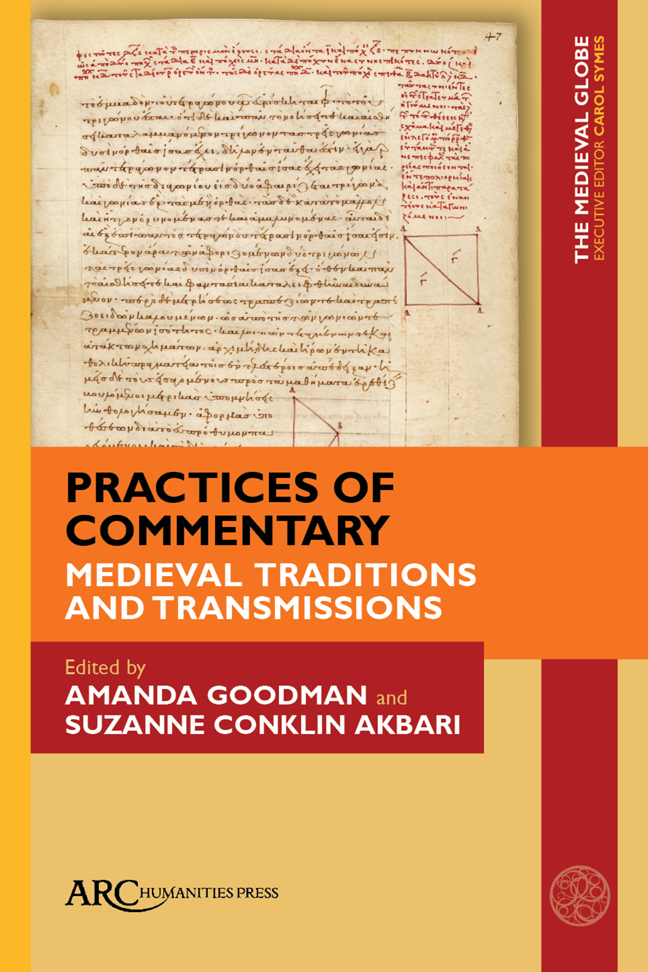Book contents
- Frontmatter
- Contents
- List of Illustrations
- Introduction: Commentary at the Crossroads
- Graeco-Roman Commentary Beyond Alexandria: Problems and Prospects
- From Plane to Space: The Narrative Arc of a Byzantine Mathematical Manual
- Periodization in the Sunni Qur'an Commentary Tradition: A Chronological History of a Genre
- On the Practice of Autocommentary in Sanskrit Sources
- Oral Commentaries and Scholarly Debates in Sanskrit Philosophy
- On the Nature of Chinese Buddhist Scriptural Exegesis: Observations on the Commentaries of Chengguan, Woncheuk, and Other Sui-Tang Exegetes
- The Mise-En-Page of a Sino-Tibetan Dunhuang Manuscript: Yuanhui's Commentary on the Laṅkāvatārasūtra
- Commentary and Multilingualism in the Ottoman Reception of Texts: Three Perspectives
- Index
The Mise-En-Page of a Sino-Tibetan Dunhuang Manuscript: Yuanhui's Commentary on the Laṅkāvatārasūtra
Published online by Cambridge University Press: 17 February 2024
- Frontmatter
- Contents
- List of Illustrations
- Introduction: Commentary at the Crossroads
- Graeco-Roman Commentary Beyond Alexandria: Problems and Prospects
- From Plane to Space: The Narrative Arc of a Byzantine Mathematical Manual
- Periodization in the Sunni Qur'an Commentary Tradition: A Chronological History of a Genre
- On the Practice of Autocommentary in Sanskrit Sources
- Oral Commentaries and Scholarly Debates in Sanskrit Philosophy
- On the Nature of Chinese Buddhist Scriptural Exegesis: Observations on the Commentaries of Chengguan, Woncheuk, and Other Sui-Tang Exegetes
- The Mise-En-Page of a Sino-Tibetan Dunhuang Manuscript: Yuanhui's Commentary on the Laṅkāvatārasūtra
- Commentary and Multilingualism in the Ottoman Reception of Texts: Three Perspectives
- Index
Summary
MUCH CAN BE learned about Buddhist commentarial practices by observing the vis-ual text-organization of Buddhist commentarial manuscripts. Conventions of page lay-out encapsulate exegetical practices, and, in turn, help shape those practices; interpreta-tive layers are informed by, and reflected in, the visualization of the text on the material page. Rather than a secondary consideration of little significance, the mise-en-page of the medieval Buddhist manuscript is best understood as a refraction of the generative processes by which knowledge systems are negotiated and new forms of knowledge are produced. This is because Buddhist commentarial practices, including bilingual com-mentarial practices, arise out of the dynamics of the medieval lecture hall, and—though the original social (oral?) context is largely lost to us—the material page captures traces of the otherwise invisible interplay between teacher and student, scholar and text, and scribe and page.
This essay examines the essential connection between Buddhist sūtra exegesis and page layout. It takes as a case study a bilingual Chinese-Tibetan Buddhist manuscript from Dunhuang's 敦煌 famous Cave 17. The manuscript is incomplete and preserved in two parts, the bulk of which is held by the British Library in London (Or.8210/S.5603); a single detached folio is held in Paris, by the Bibliothèque nationale de France (BnF; Pelliot tibétain 609). Separated by historical accident, both items were originally part of the same manuscript. We have reassembled and renumbered the surviving portions of the manuscript, integrating the detached BnF folio, and throughout this article, we use the abbreviation S.5603 to refer jointly to both. S.5603, then, designates a pair of concertinas (a book format we discuss at length below) bearing a commentary on the Laṅkāvatārasūtra (Sūtra on the Entrance to Laṅkā, hereafter also Laṅkā) by the Tang- dynasty Buddhist scholiast Yuanhui 圓暉 (active ca. 718–742). S.5603, in good condi-tion but with some damage and missing folios, contains sections of the first six fascicles or juan 卷 of what was likely originally a ten-juan work. The Chinese text, which is written in black ink from right to left in vertical columns, has been carefully annotated with corresponding passages of a Tibetan recension of the Laṅkā, written in red ink; the Tibetan text runs horizontally, from left to right, requiring the reader to rotate the book-let 90 degrees counterclockwise (Plate 8.1).
- Type
- Chapter
- Information
- Practices of CommentaryMedieval Traditions and Transmissions, pp. 139 - 170Publisher: Amsterdam University PressPrint publication year: 2023



